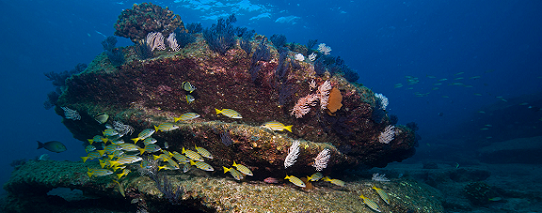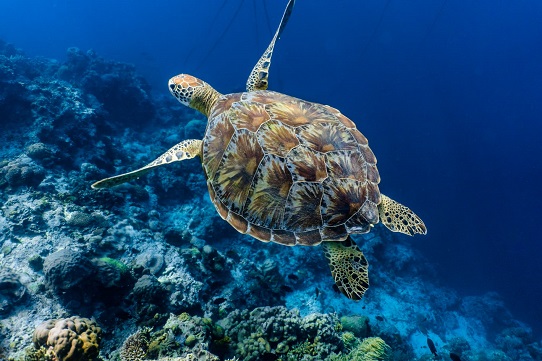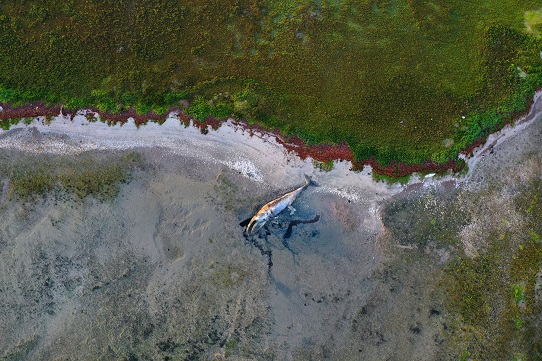导语 Introduction
关键点一
关注环境保护的人会容易陷入悲观的情绪,所以本期《蓝色脉搏》带来一些关于海洋保护的正能量。本期的观点版块中有一篇文章专门分析了海洋保护关注者的乐观理由:我们现在拥有更多知识和更好的技术,一些试验中的方法已经收获了良好的效果。而在解读板块中就有三篇文章是介绍海洋保护的新方法和新技术的。
Highlight 1
Citizens concerned about the environment can become pessimistic easily. This issue of Blue Pulse brings some 'positive energy' about marine conservation. In this issue's Perspectives section, an article is devoted to elaborating the reasons for optimism among marine conservationists: we now have more knowledge and better technology, and some experimental approaches are already yielding good results. And in the Interpretation section, there are three articles on new approaches and technologies for marine conservation.
关键点二
气候变化是《蓝色脉搏》永恒的关注之一。本期解读部分的一篇文章解释了最近发布的IPCC 第六次评估报告物理科学部分中的海洋内容。在学术部分,你可以读到关于南极的气候相关的科学的新发展,以及从脆弱性的角度对蓝碳的审视。这些发展正敦促人们在海洋政策制定中采取更综合的方法来应对气候变化。
Highlight 2
Climate change is one of the permanent interests of Blue Pulse. An article in the Interpretation section explained the ocean content in the recently released IPCC AR6. In the Academic section, you can read new developments in the climate-related science in the Antarctic and observations from the vulnerability of the Blue Carbon. Those developments are calling for a more comprehensive approach to address climate change in ocean policymaking.
时讯 News

1) 2021年8月26日-墨西哥政府承诺在Islas Marías群岛水域创建一个新的全面保护的海洋保护区,这个生物圈禁捕区占地6413平方公里--面积是墨西哥城的四倍以上,将禁止其中的所有开采性活动。
August 26, 2021—The Mexican government has committed to creating a new fully protected marine area, by banning all extractive activities within the perimeter of the Islas Marías Biosphere Reserve. The reserve is now deemed a no-take area, which does not permit fishing, mining, drilling, or other extractive activities surrounding the biosphere reserve area, making it a fully protected area. Covering 6,413 square kilometers—an area over four times the size of Mexico City
2) 7月29日,农业农村部办公厅发布了《关于加强海洋哺乳动物保护管理工作的通知》,以进一步加强海洋哺乳动物保护,促进生态文明和美丽中国建设。
On July 29, the Minister of Agriculture and Rural Affairs issued a notice on strengthening marine mammal protection and management to further strengthen marine animal protection and promote the Ecological Civilization.
3) 美国国家海洋局今年统计数据显示,2021年墨西哥湾的贫氧区达到了6334平方英里,而2020年只有2116平方英里。贫氧区是指氧气含量较低的区域,靠近海底的鱼类和海洋生物很难在此存活,这意味着超过400万英亩的海域将无法支持鱼类和其他海洋生物的生存。
NOAA 2021 statistics show that the Dead Zone in the Gulf of Mexico reaches 6334 square miles, compared to 2116 square miles in 2020. Dead Zone is the hypoxic (low oxygen) area that is deadly for fish and marine life near the bottom of the sea. It means that more than 4 million acres of habitat will be unavailable for fish and other marine life.
4) 经过十年的研发和实验,水产生物科技公司Benchmark研发的CleanTreat水净化系统第一次被使用于船只上,该船现已抵达挪威。CleanTreat水净化系统可以在处理水返回海洋之前,清除化学品和有机物,这些物质主要源自于船上治理寄生虫和虫卵的药品。
After a decade of research and development, the first CleanTreat vessel, developed by aquaculture biotechnology company Benchmark, arrived in Norwegian waters. The CleanTreat water purification system can remove chemicals and organic matter before the treated water returns to the marine environment, primarily for chemicals used to control sea lice, dead lice, and egg strings.
观点 Perspectives

1) Inverse: 我们应该以乐观的态度去看待海洋的未来,海洋保护工作正在对生态系统产生积极影响。现在我们掌握了更多知识,知道如何修复红树林等生态系统,对海洋污染控制监管能力不断提升,对渔业监管和限制水平不断加强,海洋保护区的范围在慢慢扩大,鲸鱼和海龟的数量也在回升。
Inverse: We should be more optimism to the ocean, while marine conservation efforts are generating positive result around the globe. Right now we know how to restore coastal ecosystem like mangroves. We have better regulation towards pollution and fishery and expanding Marine Protected areas. Population of whale and sea turtles are rebounding.
2) Anna Fiorentino: 去可持续的牡蛎养殖场旅游、吃人工养殖的牡蛎有助于保护野生牡蛎礁。由于过度捕捞、水污染和气候变化,野生牡蛎礁已经成为最濒危的栖息地之一。“牡蛎养殖业几乎没有温室气体排放,也几乎不需要水、饲料、化肥或食物。野生牡蛎和严格监管下的养殖牡蛎都会消耗藻类,过滤其他微粒,让更多的阳光到达海底,促进鳗草的生长,保护许多物种的栖息地。”
Anna Fiorentino: Plan your tour to sustainable oyster farms and eat caged farm oysters would help restore the wild reefs. The wild oyster reefs have become one of the most endangered habitats due to overfishing, water pollution, and climate change. "Oyster agriculture uses almost no greenhouse gas emissions, water, feed, fertilizer, or food. Both wild oysters and farmed oysters—which are grown in strictly regulated clean water—consume algae and filter other particulates, allowing more sunlight to reach the ocean floor, promoting the growth of eelgrass, a habitat for many species."
3) Chris Chase:美国打击非法、未报告和无管制捕捞(IUU)的法案将扩大海鲜进口监测计划(SIMP),以涵盖所有的进口海鲜和海产品。美国众议员Jared Huffman表示,根据报告,2019年美国海产品进口的11%来自IUU捕捞。
Chris Chase: US anti-IUU bill would expand the Seafood Import Monitoring Program (SIMP) to cover all imported seafood and seafood products. U.S. Rep. Jared Huffman indicates that 11% of 2019 US seafood imports were from IUU fishing according to a recent U.S. International Trade Commission report.
4) Katharine Owens 和 Katie Conlon:提到塑料污染,人们总是将目光集中在第三世界国家管理不当等问题。这种不公平的叙事忽略了发达国家的特权,使得发达国家从塑料污染的批判中脱身而去。人们应该了解塑料污染是一个全球性的问题,而不简简单单是个区域性问题。
Katharine Owens and Katie Conlon: The discussion on plastic pollution always focuses on the mismanagement of the Global South. Such an unjust framing ignores the privilege of the developed countries and enables the manufacturers in the developed world to hide behind the criticism. People should understand the reality that plastic pollution is a global problem instead of the regional problem.
解读 Interpretations

1) Katherine Gallagher:海藻养殖能帮助海洋复原吗?
Katherine Gallagher: Seaweed Farming: Could This Carbon-Negative Crop Help Restore Our Oceans?
海藻养殖是正在快速增长的一种水产养殖方式,它既环保又经济。因为海藻的生长只需要阳光和天然营养物质,还可以为其他海洋生物提供栖息地和食物。海藻养殖有助于缓解温室效应、海洋酸化和海洋污染。然而,海藻养殖也有潜在的负面影响。大规模的养殖可能会改变原有的生态环境,并影响那些依赖光合作用的物种。
Seaweed Farming is a fast-growing aquaculture sector that is environmental-friendly and economical. Seaweed only needs sunlight and natural nutrients to grow and serve as habitats and food. It helps mitigate the greenhouse effect, ocean acidification, and marine pollution. There are also potential disadvantages to seaweed farming. Large-scale cultivation might change the original habitat and impact species that rely on photosynthesis.
2) Dawn Costanzi 和 Elaine Young: 通过港口数据共享打击非法捕鱼
Dawn Costanzi & Elaine Young: To Better Fight Illegal Fishing, Governments Advance Information Sharing and Capacity Development
港口间的数据共享有助于阻止非法捕捞的鱼进入市场,帮助各国进行风险分析,阻止进行非法捕捞的船只停靠和卸载渔获物。比如说,当政府发现进行非法活动的船只时,可以分享其非法活动的信息,其他港口便可以根据该信息阻止船只入港。
Data exchange across ports will help keep illegally caught fish from entering the market, facilitating the sharing of reports that could help countries carry out risk analysis and prevent IUU vessels from docking and offloading catch. For example, if one government detected illegal activity by a vessel, blocks port access for that ship and shares data on that action across the region, that vessel will have a very hard time accessing any other ports in the region.
3) Susanne Rust: 东太平洋灰鲸的大量死亡
Susanne Rust: Something is killing gray whales, is it a sign of oceans in peril?
从2018年起,生活在东太平洋的灰鲸群的行为愈发古怪,并有着大量死亡情况。一些科学家将此归咎于鲸鱼数量过多,其他科学家指出,灰鲸正面临着各种危险,包括生态系统的改变、船舶撞击、渔具缠绕、塑料污染、疾病、海洋酸化和海藻森林的消失。尽管有许多猜测和假说,学术界仍然不清楚灰鲸大量死亡的原因。
Starting from 2019, grey whales in eastern Pacific were acting strangely and perishing in large numbers. While some scientist attribute this to over population of whales, other scientists point out that grey whales is facing various dangers including ecosystem alteration, ship strikes, entanglement in fishing gear, plastics pollution, disease, ocean acidification and loss of kelp forests. Despite the various hypothesis, the reason remained unknown for scholars and researchers.
4) Eric Tegler: 基于无人船艇的人工智能数据库
Eric Tegler: With A Sight, Sound and Radar Picture, Saildrone Could Build An AI Database Of Everything In The Ocean
"加州的科技公司Saildrone开发的无人驾驶船只可以将事物的声音特征、视觉特征、雷达特征和自动识别系统相结合,从而在海洋中建立一个全面、完整的人工智能数据库。这项先进技术可以应用在未来的战争或环境保护中。"
"The autonomous unmanned surface vessels (USVs) developed by California-based Saildrone combine the acoustic signature of things with the visual signature, a radar signature and an AIS [Automatic Identification System] signature. It could build up an artificial intelligence database of all the things in the ocean. That could be of huge value in future warfare or environmental conservation.”
5) Carbon Brief: IPCC第六次评估报告是怎么说海洋变暖的?
Carbon Brief: The IPCC’s sixth assessment report on climate science. What does the report say about changes to the oceans?
"IPCC报告指出,海洋吸收了自工业革命以来90%人类行为导致的热量。今天的海洋在以史无前例的速度变暖。随着表层海洋的温度上升,海洋会变得更加分层(更加稳定),因为温水的密度比冷水小。所有的情景模拟中,海洋都将持续吸收大气中的二氧化碳。"
"The IPCC report indicates that the world’s oceans have absorbed the bulk of human-induced warming since the industrial era – about 90% of the excess heat. Today's ocean is warming in a rate that is 'greater than at any point'. As the surface ocean warms, it becomes more stratified (more stable) since warm water is less dense than cooler water. Under all scenarios studied, the ocean will continue to take up CO2 emitted to the atmosphere. "
学术 Academics
1) 【气候·海洋】气候变化正在改变洋流强度
Climate Change Could Shut Down A Vital Ocean Current, Study Finds
大西洋经向翻转环流(AMOC)是一个向大西洋北部输送温暖表层水的洋流系统,学界通常认为AMOC有强、弱两种不同的运行模式,目前学界普遍认为AMOC正在从强模式向弱模式逐渐过渡,但仍缺乏对模式转换临界点的界定。我们对海面温度和盐度数据进行分析,认为AMOC可能已经从相对稳定的状态发展到了过渡的临界点。
2) 【气候·海洋】环境因素对产卵期雌性磷虾的生理影响
Environmental drivers of the physiological condition of mature female Antarctic krill during the spawning season: implications for krill recruitment
南大洋的渔业生产力依赖于南极磷虾的丰度。然而南极磷虾的重要栖息地西南极半岛的变暖速度要明显高于其他地区,海洋生态系统产生了明显的变化。我们的研究表明生态环境的变化会给雌性磷虾的产卵带来重要影响,强调了将气候变化的影响纳入南极磷虾渔业的管理模式的重要性。
3) 【生态保护】怎样通过连接自然和人文科学建立人们对边缘海系统的认识
How to develop an understanding of the marginal sea system by connecting natural and human sciences
人类活动对海洋生态系统造成多种压力,边缘海位于海陆之间的过渡区,会更大程度上受制于人类活动所带来的影响。然而人们现在对待海洋的态度与现有科学和对海洋价值的了解是脱节的。本文基于边缘海讨论了如何通过连接自然和人文科学来提升人类对海洋的认识并改变行为。
4) 【渔业管理】西部和中部太平洋金枪鱼渔业的利益研究
Mapping interests in the tuna fisheries of the western and Central Pacific Ocean
高度洄游鱼种的渔业管理非常复杂,通常跨越不同的国家管辖区和公海,需要达成有效的合作和持续治理。我们认为了解每个参与者在每个鱼种和捕捞方式中的利益是高效合作的的前提,因此,本文梳理了西部和中部太平洋渔业委员会(WCPFC)公约区中渔业参与者的相关利益,以支持更有效的区域合作。
5) 【蓝色经济】从脆弱性角度审视蓝碳生态系统服务:如何降低渔民群体的社会脆弱性
Blue Carbon Ecosystem Services Through a Vulnerability Lens: Opportunities to Reduce Social Vulnerability in Fishing Communities
蓝碳生态系统渔业是高度敏感的渔业,沿海居民多样的职业选择和民间组织的努力将会提高沿海居民面对日益变化的生存方式的适应能力。我们的研究采用混合方法,对海草床进行生态评估、进行空间分析、登陆调查、家庭访谈,将生物物理变量叠加到社会数据上,绘制敏感度和适应能力地图,以比较社区的社会脆弱性。分析显示,本研究所覆盖的社区的蓝碳生态系统是健康的,海草生态系统比红树林更脆弱。农村社区与城市社区相比,蓝碳生态系统损失几率较小,受蓝碳生态系统损失影响较低。研究强调沿海人类社区与蓝碳生态系统的关系,旨在为政府的环境政策提供洞见,特别是那些提升当地居民适应能力的政策。
6) 【蓝色经济】超越差距:将生物多样性融资置于全球经济中
Beyond The Gap: Placing Biodiversity Finance in the Global Economy
本文从政治和经济的角度出发围绕两个问题研究了生物多样性问题的解决方式:全球的经济组织如何推动了生物多样性丧失?以及现有的生物多样性金融在环境保护中表现如何?报告认为只有将生物多样性问题置于全球经济的框架下,才有可能实现颠覆性、包容性和公平的改变。
其他资料 Other resources
【报告】IPCC第六次评估报告:气候变化2021:自然科学基础
【Report】IPCC AR6: Climate Change 2021: The Physical Science Basis
报告/Report
【视频】大型海洋保护区的商业规划
【Video】Business Planning for MPAs - 1 Funding needs
视频/Video
【工具】大型海洋保护区管理工具:实时渔船活动地区
【Tool】A tool for MPAs: a map of fishing vessel activities in real-time
工具/Tool
【报告】解密海上供应链 | 转运船和燃料船的全球分析:对转运活动的监控帮助我们更好地了解远洋捕鱼船队。
【Report】Revealing the Supply Chain at Sea | A Global Analysis of Transshipment and Bunker Vessels: Monitoring of transshipment activity can be used to better understand the world’s distant water fishing fleets
报告/Report
活动 Events
>>预告 Upcoming Events
2021年9月3-11日 世界自然保护联盟2020年世界保护大会
2021.09.03-11 IUCN World Conservation Congress 2020
详情/Detail
2021年9月28日 网络研讨会:如何用科学研究的方式影响海洋政策和管理:以拉丁美洲、加勒比和非洲背景为重点的小组讨论
2021.09.28 How to do science so it influences marine policy and management: A panel discussion with a focus on Latin America, Caribbean, and African contexts
详情/Detail
2021年9月30日 河口观察“前哨站”:从环境测量到气候变化管理
2021.09.30 Estuarine Sentinel Sites: From Environmental Measurements to Climate Change Management
详情/Detail
>>回顾 Recordings
2021年6月17日 金融行业与2020年后的全球生物多样性框架
2021.06.17 The Financial Sector and the Post-2020 Global Biodiversity Framework
详情/Detail
2021年6月23日 世界海洋峰会:跨价值链合作以最大限度地减少新兴市场的海洋塑料污染
2021.06.23 World Ocean Summit Insight Hour: Collaborating across the value chain to minimize marine plastic pollution in emerging markets
详情/Detail
2021年6月28日 基于自然的解决方案与2020年后的生物多样性框架|日内瓦自然解决方案对话
2021.06.28 Nature-based Solutions and the Post-2020 Biodiversity Framework | Geneva Nature-based Solutions Dialogues
详情/Detail
>>其他 Others
本快讯两周更新一期,往期内容可以查看这里。如果您在快讯内容或形式上有任何意见或建议,欢迎发邮件至ocean@ghub.org告诉我们,也欢迎您将《蓝色脉搏》推荐给同事和朋友。
感谢实习同事李如意,张辰熙对本期快讯的贡献。
题图:Islas Marías生物圈保护区的岩礁和硬珊瑚Octavio Aburto | 摄



